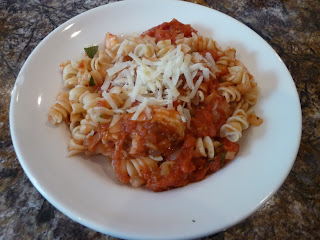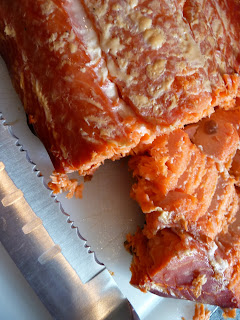My culinary adventures take me to Mozambique, a large country located in southeastern Africa. The history of Mozambique can be best simplified and summarized by three emigrations. First, there was the emigration of Bantu peoples, who brought agriculture and farming to the area around 300 A.D. Second, there was the arrival of the Swahili and the Arabs, who established commercial and military ports in the land that would become Mozambique. Third, and most significantly, there were the Portuguese, who colonized the country in the early 16th century. The Portuguese controlled Mozambique as a colony for more than three hundred years, leaving an indelible print upon the culture and cuisine of that country and its people.
The Portuguese influence is perhaps the most apparent when it comes to the ingredients used by Mozambican cooks. The Portuguese introduced cassava and cashew nuts as crops for agriculture, along with maize, rice, sorghum and potatoes. The Portuguese also introduced the use of certain spices, such as bay leaves, coriander, garlic, red sweet peppers, chile peppers, onions, paprika and wine.
Moreover, this influence of the Portuguese extends beyond ingredients and reaches the dishes prepared in Mozambican kitchens. For example, Mozambicans have their own version of Feijoada, the Portuguese bean stew and condiments like Piri-Piri Sauce. They have also incorporated roasting methods introduced by the Portuguese to create dishes such as Frango a Portuguesa (Chicken, the Portuguese way).
For this challenge, I wanted to go beyond the influence of the Portuguese and reach for a dish that is reflective of the indigenous peoples of Mozambique. I decided to make Matata, a clam and peanut stew enjoyed by local Mozambicans. The principal ingredients for this stew are simple -- clams, peanuts, pumpkin leaves -- highlight the local nature of the dish. However, I could not complete the meal without at least doing one dish that is influenced by the Portuguese. That dish is Camarao Mozambique, which is as fiery shrimp dish that is heavily influenced by chiles and wines of the Portuguese.
THE SAUCE
Before making Camarao Mozambique, I need to make one of the ingredients for that dish, Piri Piri Sauce. This sauce is basically a hot pepper sauce that combines Portuguese and African influences. The Portuguese contributed the peppers, which originated in the New World. Explorers and traders brought the peppers to Portuguese colonies in Angola and Mozambique. In Mozambique, the peppers acquired the name of "piri piri," which is "pepper pepper" in Swahili. This recipe is adapted from one by Jorge Jordão, the chef at Zambi, a restaurant in Maputo, Mozambique. I could not find the right red chiles, so I used red bell peppers and added some ground Mombosa pepper, which is said to be the descendant of the peppers brought to Africa by the Portuguese.
PIRI-PIRI SAUCE
Ingredients:
2 red peppers
1 teaspoon of ground Mombosa (Piri Piri) pepper
(you can use more if you want a more spicy dish)
3 tablespoons of fresh lime juice
2 teaspoons of dark brown sugar
1/2 tablespoon of olive oil
1/2 tablespoon of finely chopped fresh ginger
1/4 tablespoon of white wine vinegar
1/4 teaspoon of kosher salt
1 clove of garlic
Directions:
Add all of the ingredients in a blender and puree into a chunky sauce.
THE APPETIZER
With the sauce, I can turn to the Camaro Mozambique. As noted above, Portuguese explorers introduced chile peppers to Mozambicans. However, it was the Mozambicans who combined those peppers with shrimp. In doing so, local cooks created a dish that has become very popular, not only in Mozambique, but also in Portugal itself.
CAMARAO MOZAMBIQUE
Serves 3-4
Ingredients:
7-10 threads of saffron
1 pound of shrimp, deveined but not deshelled
1/8 cup of olive oil
1/8 cup of water
5 cloves of garlic, roughly chopped
4 tablespoons of butter
1/4 bottle of white wine (like a Vinho Verde)
1/2 teaspoon of paprika
1 tablespoon of hot crushed red pepper
1/2 lemon, juiced
1/4 cup, flat parsley, coarsely chopped (optional, for garnish)
Portuguese piri-piri sauce , to taste
Directions:
1. Steep the saffron. Put the saffron in the water and let it steep. You could let it steep overnight, but usually I just let it steep for fifteen minutes to thirty minutes.
2. Saute the shrimp. Place a deep saucepan on medium-high heat, when the pan warms, add the olive oil. When oil begins to shimmer add the shrimp and sauté until they just turn pink. Remove the shrimp from the pan with a slotted spoon and keep the juices and oil in the pan. Put the shrimp aside and keep them warm.
3. Saute the garlic. Add the garlic to the pan and sauté for 2-3 minutes until golden. Do not let the garlic brown or burn.
4. Make the sauce. Add the saffron and water, wine, paprika, crushed pepper, hot sauce, and lemon juice. Bring this mixture to a boil, adjust to a lively simmer and allow it to reduce and thicken slightly.
5. Finish the shrimp. Return the shrimp to the pan and continue simmering, stirring frequently for about 2-3 minutes.
6. Finish the sauce. Add the butter to the pan stirring frequently. Once butter melts, stir one more time, remove from heat and adjust salt and pepper to taste.
THE MAIN COURSE
Finally, I turn my attention to the main course, which is the subject of the Around the World in 80 Dishes Challenge. The main course and challenge for Mozambique is Matata, a clam and peanut stew with pumpkin leaves. I had to make two alterations to this recipe. The original recipe called for the use of canned clams. There is nothing wrong with using canned clams (other than the fact that clams are living shellfish and once removed from their shell, clams have to be preserved). I had access to fresh cherrystone clams and bought three small bags of clams to use in this recipe. The one drawback to using fresh clams is that I had to shuck them, which is time consuming but well worth the effort. The same goes for the peanuts. Bottles of peanuts line shelves in a grocery store; however, I bought fresh peanuts and shelled them myself.
However, the original recipe also calls for pumpkin leaves. Unlike the clams and peanuts, I did not have a source for fresh pumpkin leaves. The authors of the recipe (and authors of other Matata recipes) anticipate the lack of pumpkin leaves. They suggest fresh spinach leaves as an alternative. I readily accepted this alternative and proceeded to make the dish.

MATATA (CLAM AND PEANUT STEW)
Ingredients:
1/2 cup of chopped onions
1 ounce of extra virgin olive oil
1/2 cup of chopped peanuts
1 tomato, diced
2 cups of clams, chopped
1/2 tablespoon of sea salt
1/4 teaspoon of ground black pepper
1/2 teaspoon of crushed red pepper
3/4 of a pound of fresh spinach
Directions:
1. Saute the onions. Heat the olive oil in a pan on medium heat. Add the onions and simmer until soft, but not brown.
2. Add ingredients (except the spinach). Add the peanuts, tomato, clams, salt, black pepper, and red pepper. Stir and simmer for about thirty minutes.
3. Add the spinach. Add the spinach and cover the pan. When the spinach has wilted, the dish is ready to serve.
4. Plate the dish. Matata is usually served over rice. Plate some rice in the center of the bowl and spoon the Matata around the rice.
* * *
Overall, I think this challenge was a success. I was most pleased with my variation on the Piri-Piri sauce. I confronted a lack of red chiles by substituting ingredients to still achieve the desired result ... a spicy sauce. My efforts also made for a sauce with more complex flavors, sweet up front, followed by vinegar with a kick in the end. The Camarao Mozambique and Matata also turned out well for the first time that I made each dish. I was surprised how much I liked the Matata, given the fact that I am not a big fan of spinach.
With this challenge in the books, it is time to turn to the next one. Until next time ...
ENJOY!
 I was standing in front of the seasonal beer selection at a local store when I saw the Elysian Brewing Night Owl Pumpkin Ale. The Elysian Brewing Company was founded in 1995 by three individuals: Dick Cantwell, Joe Bisacca, and David Buhler. The brewery opened in the Capitol Hill neighborhood of Seattle, Washington. The brewery has expanded over the years, establishing its own brewpub called TangleTown. The brewery also opened Elysian Fields, a large brewpub near Qwest Field and Safeco Field. At these locations, Elysian Brewing Company serves a total of almost twenty of its own beers, including the Night Owl.
I was standing in front of the seasonal beer selection at a local store when I saw the Elysian Brewing Night Owl Pumpkin Ale. The Elysian Brewing Company was founded in 1995 by three individuals: Dick Cantwell, Joe Bisacca, and David Buhler. The brewery opened in the Capitol Hill neighborhood of Seattle, Washington. The brewery has expanded over the years, establishing its own brewpub called TangleTown. The brewery also opened Elysian Fields, a large brewpub near Qwest Field and Safeco Field. At these locations, Elysian Brewing Company serves a total of almost twenty of its own beers, including the Night Owl.  The Night Owl pours a dark orange/copper color, with a thin layer of foam that quickly recedes to the edges of the glass. The aromatic elements of this beer include pumpkin, along with a darker cinnamon or sugar. What sets the beer apart from others in this style is that, unlike other pumpkin ales that I have tried, the aromas of this beer feature pumpkin more than the spices.
The Night Owl pours a dark orange/copper color, with a thin layer of foam that quickly recedes to the edges of the glass. The aromatic elements of this beer include pumpkin, along with a darker cinnamon or sugar. What sets the beer apart from others in this style is that, unlike other pumpkin ales that I have tried, the aromas of this beer feature pumpkin more than the spices.










































